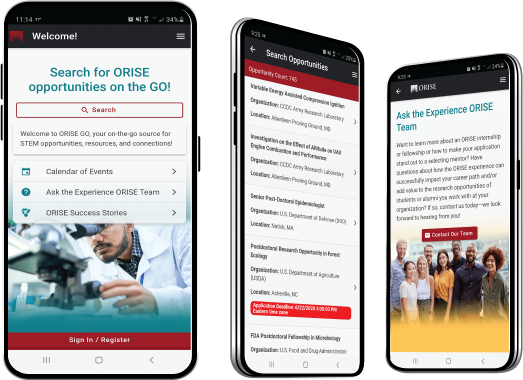EPA Internship Simulating Atmospheric Transformations of Airborne Pollutants
Connect with ORISE...on the GO! Download the new ORISE GO mobile app in the Apple or Google Play Store to help you stay engaged, connected, and informed during your ORISE experience and beyond!
-
An application
-
Transcript(s) – For this opportunity, an unofficial transcript or copy of the student academic records printed by the applicant or by academic advisors from internal institution systems may be submitted. All transcripts must be in English or include an official English translation. Click here for detailed information about acceptable transcripts.
-
A current resume/CV, including academic history, employment history, relevant experiences, and publication list
-
Two educational or professional recommendations. Click here for detailed information about recommendations.
*Applications will be reviewed starting Nov. 28 and continue until the position is filled. Click here for information about the selection process.
EPA Office/Lab and Location: A research opportunity is available at the Environmental Protection Agency (EPA), Office of Research and Development (ORD), Center for Environmental Measurement and Modeling (CEMM), Atmospheric and Environmental Systems Modeling Division (AESMD) located in Research Triangle Park, North Carolina.
EPA’s Office of Research and Development is focused on enhancing air quality modeling approaches to inform regulatory decisions for permitting and characterization stationary sources, specific attention to near-source air quality modeling capabilities.
Research Project: Anthropogenic activity releases chemicals into the air that can directly affect human health or react and transform into secondary products with health impacts. EPA develops tools in support of clean air and chemical safety regulation to mitigate human health impacts of emissions to air. This project will seek to improve the representation of the lifecycle of organic and inorganic compounds from release into the atmosphere, through chemical and physical processing, to removal by deposition in models such as the Community Multiscale Air Quality (CMAQ) model (https://www.epa.gov/cmaq). The project will focus on the representation of atmospheric chemistry in the chemical mechanism. A chemical mechanism uses surrogate compounds to parameterize the full complexity of tropospheric chemistry. Mechanisms are expected to perform well in predicting ozone and fine particles under a variety of conditions including urban and remote, near surface and free troposphere, and winter and summer. Mechanisms were traditionally designed to capture ozone formation and species of emerging concern or important for secondary organic aerosol (SOA) are often neglected or treated in a way that is disconnected from the gas phase. Updated mechanisms are needed. As a result, EPA is leading development of a new chemical mechanism, the Community Regional Atmospheric Chemistry Multiphase Mechanism (CRACMM, Fact sheet available: https://www.epa.gov/cmaq/cmaq-fact-sheets).
Learning Objectives: The research participant may develop scientific hypotheses and perform data analysis to investigate how emissions as well as their oxidation products evolve in the atmosphere. This project has the potential to inform chemical transport model methodologies and/or to identify priority areas for development of mechanisms. The research participant will learn how information flows from emission inventories through chemical mechanisms to policy analysis. The research participant will collaborate with a team of internal and external researchers and balance detail and computational efficiency in algorithm development. The research participant may be involved in the following research activities:
- Determination of chemical reaction products via literature survey or data analysis
- Box modeling (e.g., with F0AM)
- Emission inventory analysis
- Regional chemical transport modeling with CMAQ
- Interpretation of field and laboratory data
Mentor(s): The mentor(s) for this opportunity is Havala Pye (pye.havala@epa.gov). If you have questions about the nature of the research please contact the mentor(s).
Anticipated Appointment Start Date: June 1, 2023. All start dates are flexible and vary depending on numerous factors. Click here for detailed information about start dates.
Appointment Length: The appointment will initially be for one year but shorter appointments may be considered. The appointment may be renewed upon EPA recommendation and subject to availability of funding.
Level of Participation: The appointment is full-time.
Participant Stipend: The participant will receive a monthly stipend commensurate with educational level and experience. Click here for detailed information about full-time stipends.
EPA Security Clearance: Completion of a successful background investigation by the Office of Personnel Management (OPM) is required for an applicant to be on-boarded at EPA.
ORISE Information: This program, administered by ORAU through its contract with the U.S. Department of Energy (DOE) to manage the Oak Ridge Institute for Science and Education (ORISE), was established through an interagency agreement between DOE and EPA. Participants do not become employees of EPA, DOE or the program administrator, and there are no employment-related benefits. Proof of health insurance is required for participation in this program. Health insurance can be obtained through ORISE.
ORISE offers all ORISE EPA graduate students and Postdocs a free 5 year membership to the National Postdoctoral Association (NPA).
The successful applicant(s) will be required to comply with Environmental, Safety and Health (ES&H) requirements of the hosting facility, including but not limited to, COVID-19 requirements (e.g. facial covering, physical distancing, testing, vaccination).
Questions: Please see the FAQ section of our website. After reading, if you have additional questions about the application process please email ORISE.EPA.ORD@orau.org and include the reference code for this opportunity.
The qualified candidate should be currently pursuing or have received a bachelor's, master's, or doctoral degree in one of the relevant fields (e.g. Physical Science, Mathematics, Engineering). Degree must have been received within five years of the appointment start date.
- Willingness to learn to perform computational modeling.
- Knowledge of a data processing/data analysis language (MATLAB, R, Fortran, Python, etc) and/or chemistry box model is desired, but not required.
- Familiarity with chemical transport modeling is not necessary.
- Participant will learn about the Community Multiscale Air Quality (CMAQ) model and how different aspects of atmospheric science (field, laboratory, and modeling work) interact.
- Familiarity with atmospheric chemistry fundamentals or computational methods would be advantageous, but not required.
- Citizenship: U.S. Citizen Only
- Degree: Bachelor's Degree, Master's Degree, or Doctoral Degree received within the last 60 months or currently pursuing.
- Discipline(s):

 ORISE GO
ORISE GO

The ORISE GO mobile app helps you stay engaged, connected and informed during your ORISE experience – from application, to offer, through your appointment and even as an ORISE alum!





